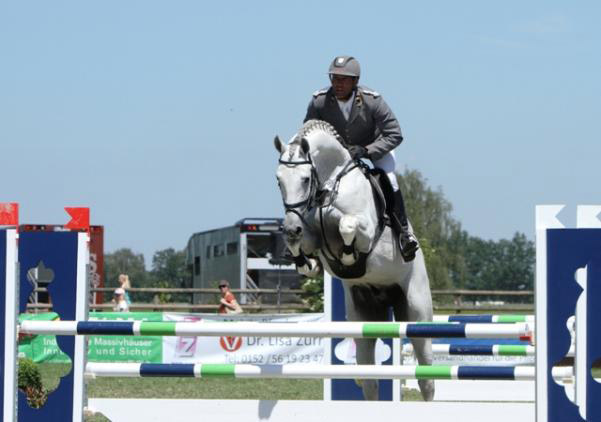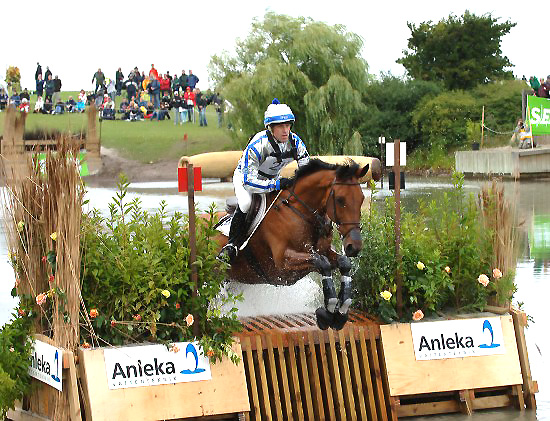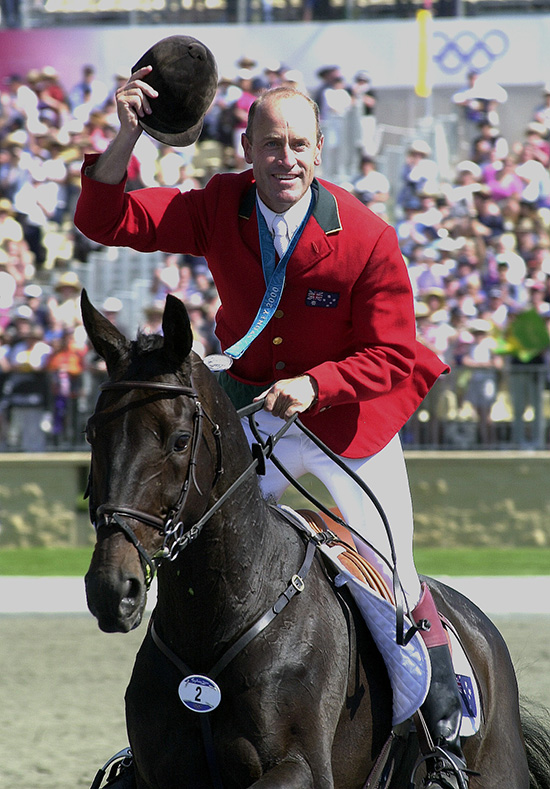Rhythm and Seeing Your Stride with Andrew Hoy
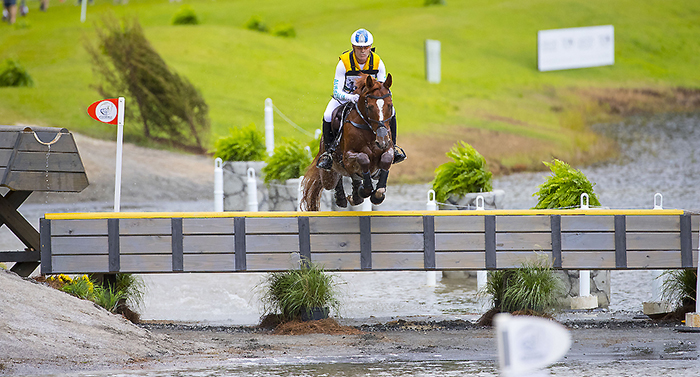
Andrew and Vassily de Lassos on course at the Tryon WEG – © DigiShots
Riding cross country is against the clock, but this doesn’t mean that you have to go fast. It means that you have to take good lines. Every extra ten feet, or three and a half metres that you travel, costs you one second. So if you can save half a metre on the approach and half a metre on the landing, and there are thirty jumps on the course, you come in half a minute quicker than someone else.
People might say to you – ‘You go so fast,’ but you didn’t go fast, you just had a nicer, tighter line than the others. However even when you are determined to take tighter lines, there are certain fences on a course that you need to take time out to jump.
Take the water complex…
It’s not very intelligent to come swanning around on a tight line and attack the jump on an angle, only to have the horse say ‘Ooh water’, and run out! That means you have twenty penalties and you could have spent an extra time on your approach to get the same penalties.
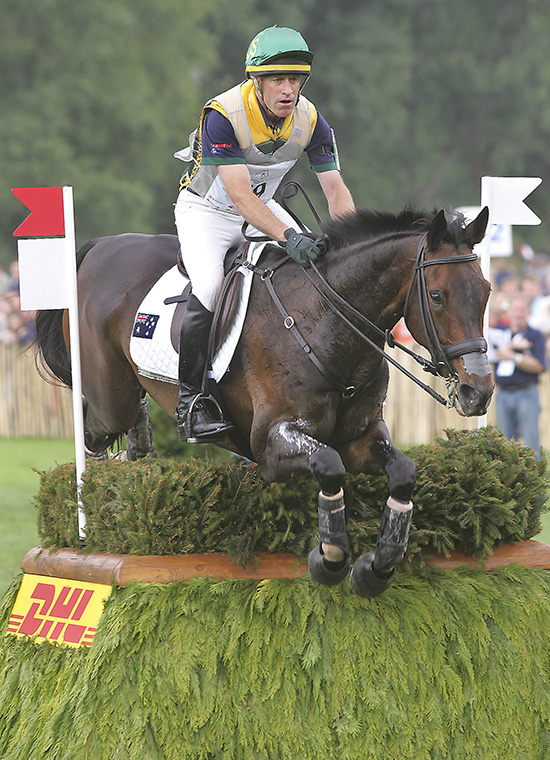
Part of the Silver Medal Team at the 2006 WEG in Aachen
There’s no way that you wouldn’t spend a minute going an extra five or six metres to make sure that you get your line right, and get the horse in a nice even rhythm. There are times on a course when you need to take time out to jump.
Don’t ride to other people’s ability – always ride to your ability and your horse’s ability. Safety is a priority.
I’ve ridden in lots of team situations where other team members have said they were going to be going a different way, or that they thought that they would ride a particular line, but if I wasn’t comfortable with that, I would take the longer option.
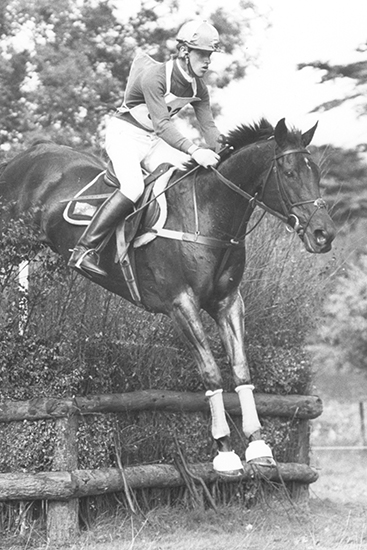
Andrew and his first star, Davey at Burghley – winners
When I won Burghley in 1979, I took all the soft options, and I was one of the only two riders to come in under time. You can still win by taking long options, don’t think you’ve got to be a hero and go the straight way.
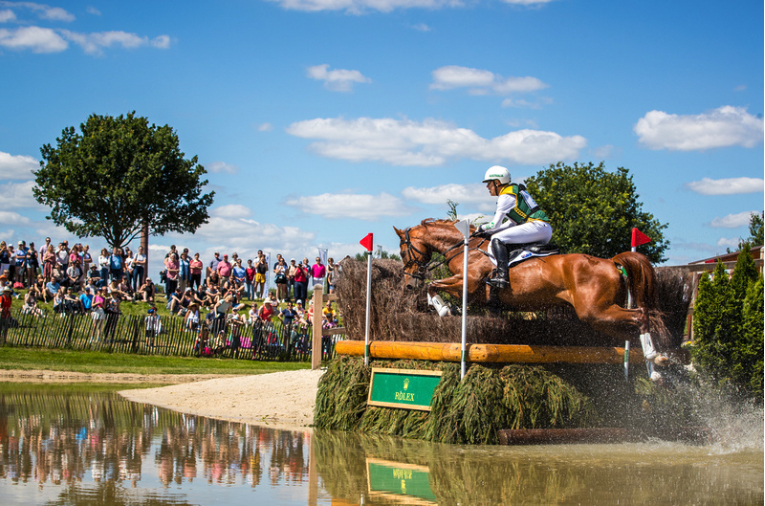
And Vassily, the latest star – placing at Aachen 2022:
“What I’ve learnt over the years is that every horse is a true individual. Every horses has its own personality and it is important to me, as an athlete and as a horse lover to be able to actually work with that personality – and that’s something that Vassily and I have got in a very unique way. I’m the only person that ever sits on him, no one else sits on him, no one else does anything with him other than to lead him to the field and grooming him.”
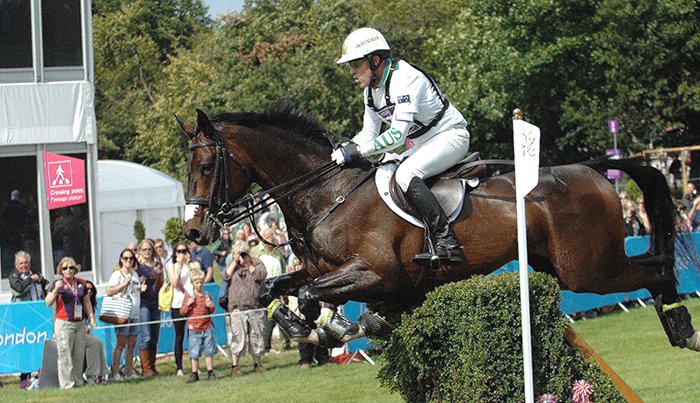
Rutherglen at the London Games in 2012
If you’ve got a sloping ski jump, for example, you can just keep running, but you need to see your distance from a long way off. Don’t be fiddling around two or three strides out trying to get it right.
You need to work on seeing your distance – and that’s where you can save time at home, with simple exercises like cantering to a pole on the ground and practising seeing your distance come up quickly. There are always things you can use where you ride every day. You need to learn to run and just gallop over little drains. If you are creative there are lots of ways you can practise.
Here’s a simple exercise that you can practise when you are cantering for your fitness work. Look for a fence post or a marker in your working area, and say to yourself, okay I’ll count my strides to that, so you get an idea of how far you are away. Try to be precise, and get your horse’s feet just beside your marker. Years ago, I used to see thistles in the paddock and I used to ride to them and try and get my horse to jump over them and that helps you to hold your horse on a line.
Invariably the reason horses stop or run out, is that riders do not keep the horse straight and hold the horse to the fence. The rider gets two or three strides from the fence, and then softens with the hand and allows the horse to run sideways. You have to ride positively, and give the horse positive vibes.
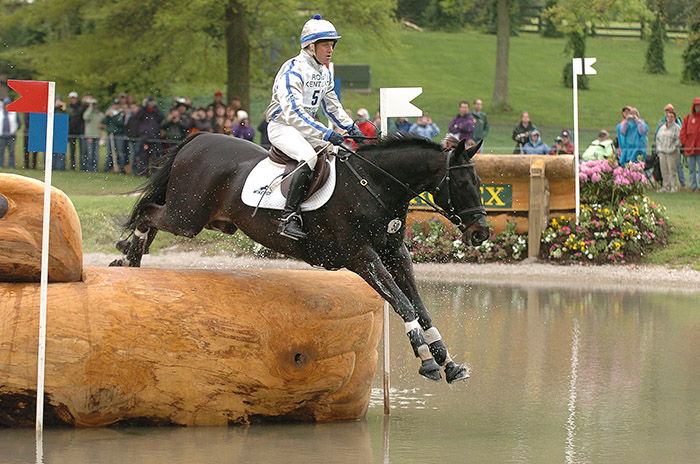
Moonfleet at Kentucky Rolex
With any cross country fence, you have to look at the top rail of the fence, do not look beyond it in the trees, don’t be a ‘tree-gazers’. You have to look at the fence, because that is the only way that you can judge your distance to it, and so assist the horse in getting there in the right spot. Your balance and timing comes from your eye.
Jumping is just an elevated canter stride for the horse and that’s what you want it to be. You don’t want it to be huge effort, you should be able to just allow your horse to be cantering along and see your distances up to six or seven strides away from the fence – then you either hold for the distance, or move your horse along with a little longer stride. If you leave it for the last three strides to see your distance, it then becomes very difficult to change your horse’s stride. You have to make a judgement early.
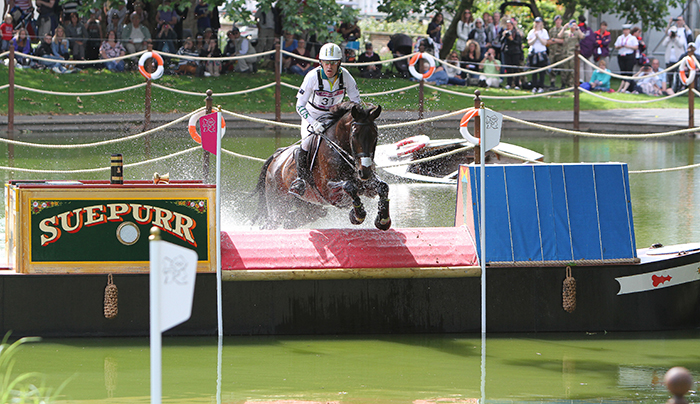
The water at London in 2012
That’s what a lot of people are not game to do, to make that judgement early. So focus on the top rail and just keep hold of the horse and keep him in a good rhythm coming to the fence, and then you should be able to see your distances.
Now with riding cross country you need to be out of the saddle as you gallop along between your fences. Make sure that you have your backside out of the saddle. If you ever get the opportunity to ride in a CCI**** event, you need to consider how many strides your horse going to take on the speed and endurance day. It’s a lot of kms and that’s a lot of strides.
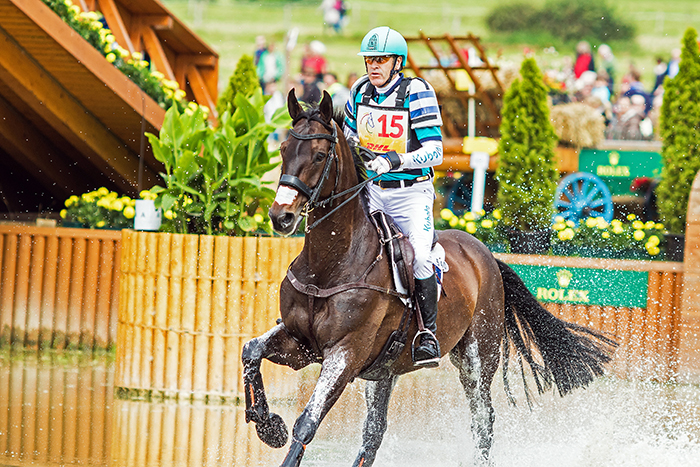
Out of the saddle and eyes on the top of the next fence…
If you are going to hit your backside in the saddle every stride of the cross country, you take a little bit of energy out of your horse every stride. It’s only a little bit of energy, but when you are running the last 500 metres of the cross country, and the horse is getting tired, because he’s jumped a lot of fences, you need every ounce of energy. Too many people use the horse’s energy up by bouncing around on his back. You, the rider, need to carry your body weight and keep your own balance above the horse and not bounce around on his back.
The art of cross country is allowing your horse to gallop along in rhythm and jump out of his stride.
For instance, jumping the twelve foot wide ditch, it can either be part of his stride – or it could be a huge effort because you’ve taken off half a stride away because you haven’t made a good enough judgement coming in to it.
You don’t ride bigger fences any different to the way you ride smaller fences. You need to keep hold, keep the horse in a nice balance, and keep him going forward and away from the leg.
If you watch the really good riders they do allow their horses to run along and jump. If you watch Mark Todd, now there’s a rider who can just run along and jump the fences without any effort. The horse has a limited amount of energy and a limited number of miles, you must allow him to run freely and that’s why I always ride shorter cross country and have my backside out of the saddle.
Next Andrew tells us how to train for the different fences on course:
Breeding eventers? Check out the best European bloodlines available from International Horse Breeders: www.ihb.com.au Stallions like Grey Top –
Check out the range of stallions available especially suited for breeding top eventers – Email Glenis: sales@ihb.com.au for more information!
WATER
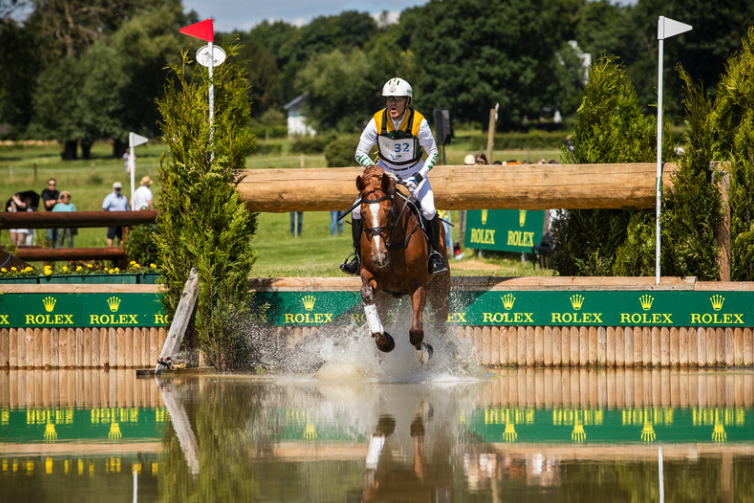
The latest star through the water at Aachen
When introducing your horse to water, you start off at the walk, you don’t want to go galloping at everything. You keep the contact with the reins as though you’re riding to a fence and just allow the horse to walk through the water. You should look at the water, like any other obstacle, but that doesn’t mean you have to put your head down.

You walk the horse through the water and you do this time and time again. Allow yourself to go with the horse, don’t get too far forward and when the horse decides to step into the water, don’t lean too far back. Just sit there, and sit there quietly. When you get the horse into the water, don’t let him paw, make him just stand in the water, it’s not a game. You need to have the horse listening to you for the indication to go in from your leg. If you can walk the horse through the water, then everything else becomes easy.
Wait until the horse gets confident and then you can move on to a steady trot, and then hold a nice steady canter through the water. You look at the edge coming into the water, and then the edge going out.
On jumping ditches…
One of the things about walking cross country courses is that once you’ve seen the ditch, don’t stand and look into it. They never get any smaller! I’ve spent hours looking at them wondering how am I going to get over them, around them, through them – they never get smaller!
Remember when your horse is galloping across country, he takes about a 4m, or 12 to 15 foot stride. So if a ditch is 12 foot wide, it doesn’t matter if it’s 5 foot deep…
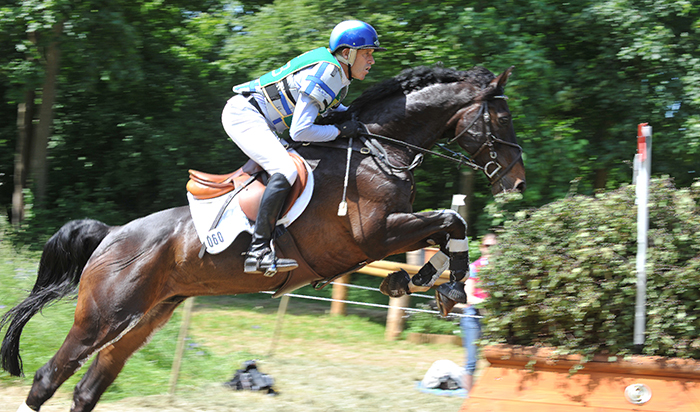
Cheeky Climbo at Wiesbaden clears a fence with a ditch in front
Make sure when you are jumping a ditch, you get right to the very edge and then it is just a canter stride. If you take off half a stride away, then it is a long way to the back of the ditch and you begin to hate them.
Now how do you teach and train your horse to accept ditches? By going back and walking over a very small ditch, just walk back and forward over it, then trot and canter back and forward over it, then find another one a little wider and do the same. It is amazing what you can walk over, you can walk over a quite wide ditch and then trot and canter over it, and that helps build confidence in both you, and your horse.
When you’re jumping a fence with a ditch in front of it, remember that a horse takes off six feet in front of the fence. So as long as that ditch is not more than six feet wide, the horse is never going to step into it. The only time he’s going to step in a ditch in front of a fence, is if you lean forward and look in the ditch and allow the horse to run along and put his head down.
Banks…
Riders cause problems at banks by riding too quickly to the bank, and being too anxious to get up the bank.
Let’s start with a very good exercise to teach everyone to wait for the fence to come to them.
Just walk to the bank holding the horse in walk, walk them to it and let the horse step up onto the bank. Keep the reins, don’t give with the reins and indicate to the horse to jump up. Don’t anticipate the jump and lean forward. Keep your eyes on the edge of the bank. If your horse doesn’t step straight up, just sit there quietly and let him work out what he has to do. Just keep your leg on and don’t get anxious, don’t start to kick a lot.
Then when you move on to trotting and cantering to the bank, it’s easy because you’ve learned to sit and wait. It’s good exercise for a horse that wants to run and get strong. He realises that he can wait and still get up the bank.
Jumping up a bank is just like any other fence except the horse touches on the top of the fence. Jumping down a bank, think of it as just the landing part of the jump. The distance opens up between your shoulders and the horse’s neck. It’s the same as landing over a fence, you need to keep the direct line between the shoulder, the knee and the ball of the foot. That makes it easy to let your horse canter down the bank.
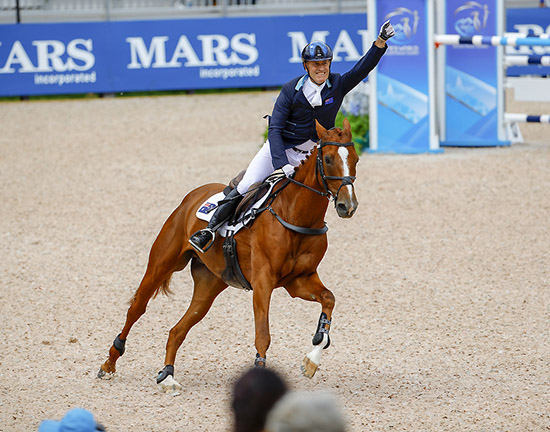
Andrew Hoy – Vassily de Lassos finish their showjumping round at the 2018 WEG
© DigiShots
Conclusion…
An event rider needs to stay focused in the right area. It doesn’t matter if it’s the dressage or the showjumping or the cross country. Before the Seoul Olympics, a friend said to me, ‘I’d wish you good luck, but I’m not going to, because you make your own luck’. I’ve always remembered that, because the good riders are not lucky, they make it happen. When you are going cross country if you want to be successful, you have to get the best your horse can offer.
Read Andrew’s interview from the 2018 WEG at Tryon: http://www.horsemagazine.com/thm/2018/09/andrew-hoy-exclusive-interview/



